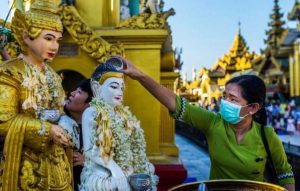
Chinese New Year celebration in Chinese communities in all corners of the globe is characterized with heart-warming traditional greetings like “Jinyumangtang” – (May wealth fill your hall!); “Dazhanhongtu” (May you realize your aspirations!); “Wanshiruyi” (May your wishes be fulfilled!); “Zhaocaijinbao” (Acquire wealth to gain more jewels!). All these Chinese New Year greetings pertain to well-wishes about prosperity and happiness.
Prosperity and happiness are obviously related to Buddhist teaching of blessings derived from wholesome behavior. Ordinary Chinese Buddhists conceive that wholesome results derived from good karmas (actions) are a source of happiness. Such mundane happiness is superficial and temporary. It is merely hedonist pleasure. Hedonist pleasure however is not genuine happiness. Genuine happiness is spiritual pleasure without denying worldly sensual pleasures. Buddhism like any other world religion teaches us the art of genuine happiness through altruistic giving of non-clinging. During Chinese New Year celebration, giving away red packets of cash and bonuses to others concurs with Buddhist altruistic giving.
When Chinese New Year celebration is sanctified with Buddhist wisdom, the Chinese New Year wishes for prosperity and happiness are more meaningful. It produces a hybrid celebration of Chinese New Year celebration and spiritual ascent for genuine happiness. Mundane attainment of happiness is samsaric. Supra-mundane attainment of happiness is nirvanic. What is samsaric, is the relative phenomenal world of secular attainment. What is nirvanic is the absolute principle of human spiritual maturity and adulthood. The Unity of both the mundane and the supra-mundane is genuine happiness. Mundane and supra-mundane attainments are inseparable to produce genuine happiness.
How do we gain genuine happiness from Buddhist wisdom to sanctify or justify celebration of Chinese New Year? The standard measurement of genuine happiness is altruistic pleasure while denying egoistic pleasure. Altruistic pleasure is sensual pleasure derived from making others happy through giving (dana) of non-clinging. Egoistic pleasure is sensual pleasure derived in satisfying one’s own pleasure through reception instead of giving without the concern for the happiness of others. Chinese New Year celebration is full of altruistic pleasure that intensifies the joy of festive celebration. The Chinese New Year celebration is altruistic because giving is more active than receiving for the generous elders or bosses or hosts.
Buddhism does not require a Buddhist to renounce personal pleasure to partake of altruistic giving. Buddhism teaches a Buddhist to enjoy life by making others happy through altruistic pleasure. Altruism is effected by renouncing egoistic pleasure. A traditional Chinese New Year Greeting promotes and fosters altruistic happiness. Thus, a Chinese New Year celebration is also a Buddhist celebration. Otherwise, it becomes only an ordinary cultural or traditional celebration of the Chinese lunar New Year. The Chinese New Year celebration can thus be further elevated spiritually through Buddhist wisdom of altruistic compassion. Just make the correction from egoistic pleasure to altruistic pleasure to celebrate the Chinese New Year. Greet others with utmost sincerity in this Chinese New Year celebration. Buddhist practice is about mental correction. Egoistic pleasure is self-pleasure. Altruistic pleasure is Non-self pleasure. Non-self pleasure is Buddha pleasure. Renowned Asian Pure Land Master, Ven. Chin Kung always stresses, “Learning the Dharma is the greatest living joy.” The greatest living joy is altruistic pleasure. A Chan Patriarch says, “Everyday is a good day. Every day is New Year celebration.” Make every day a daily New Year celebration.











